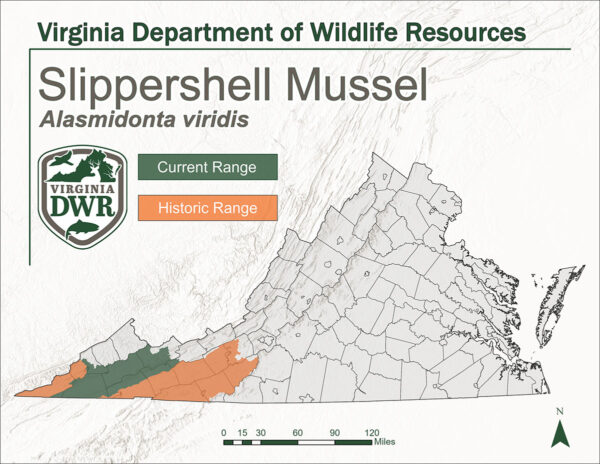Slippershell Mussel affixed with a PIT tag for monitoring
Subadult Slippershell Mussel
Slippershell Mussel with Hallprint Tags
Fact File
Scientific Name: Pressodonta viridis
Classification: Freshwater Mussel, Family Unionidae
Conservation Status:
- State Endangered in Virginia
- Species of Greatest Conservation Need-Tier 1b on the Virginia Wildlife Action Plan
Size: 55 mm
Life Span: 18 years
Identifying Characteristics
- Small, thick, and slightly inflated shell
- The anterior end is round, and the posterior end is square
- The ventral margin is slightly curved
- The outer covering of the shell (periostracum) is yellowish-brown in color, and marked with fine brown or green rays
- The inner portion of the shell (nacre) is white and iridescent
Habitat
The Slippershell Mussel primarily lives in small streams, although historic records indicate it once inhabited shoals and riffles of larger rivers. It can be found in mud, sand, and gravel substrates, and among the roots of aquatic vegetation.
Distribution
The Slippershell Mussel occurs throughout the headwaters of the Clinch and North Fork Holston River watersheds. Historically, populations could be found throughout the Powell, Middle Fork Holston, and South Fork Holston River watersheds in the upper Tennessee River basin. Museum collections of shell material indicate it once occurred in the New River basin, though living individuals have never been reported.

Life History
Freshwater mussels have a very unique life cycle. Parasitic larvae, called glochidia, develop in the gills of the female mussel. Once mature, the glochidia are expelled from the gills of the mussel and must attach to the gills of a suitable host fish, where they complete their transformation into a juvenile mussel. They then detach from the fish and begin their free-living existence on the river bottom.
Some freshwater mussels are host-specialists, meaning that metamorphosis can only occur on a limited number of closely related fish species, while others are host-generalists, with the ability to complete their life cycle using many different species. The Slippershell Mussel relies on multiple benthic-dwelling species for successful transformation: Johnny Darter (Etheostoma nigrum), Mottled Sculpin (Cottus bairdii), and Banded Sculpin (Cottus carolinae).
Conservation
The Slippershell Mussel has experienced a drastic decline throughout Virginia, with only a few small populations remaining. DWR’s Aquatic Wildlife Conservation Center (AWCC) is currently working to restore this species throughout the upper Tennessee River basin in southwestern Virginia.
Special Considerations
Freshwater mussels are extremely imperiled organisms. DWR regulates the take and possession of freshwater mussels occurring within the state. It is unlawful to take mussels from any inland waters in the Commonwealth except as provided for in §§ 29.1-418 and 29.1-568 of the Code of Virginia. Additionally, the Slippershell Mussel is listed as an endangered species under Virginia law. It is a violation of state law to harass, harm, or take the Slippershell Mussel in Virginia.
For more information, see Virginia’s Endangered Species Act.
Last updated: August 12, 2025
The Virginia Department of Wildlife Resources Species Profile Database serves as a repository of information for Virginia’s fish and wildlife species. The database is managed and curated by the Wildlife Information and Environmental Services (WIES) program. Species profile data, distribution information, and photography is generated by the Virginia Department of Wildlife Resources, State and Federal agencies, Collection Permittees, and other trusted partners. This product is not suitable for legal, engineering, or surveying use. The Virginia Department of Wildlife Resources does not accept responsibility for any missing data, inaccuracies, or other errors which may exist. In accordance with the terms of service for this product, you agree to this disclaimer.

